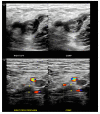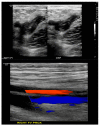Blood Being Tricky: Anticoagulation-Resistant Venous Thromboembolism (VTE)
- PMID: 35711251
- PMCID: PMC9192361
- DOI: 10.7759/cureus.25914
Blood Being Tricky: Anticoagulation-Resistant Venous Thromboembolism (VTE)
Abstract
Venous thromboembolism (VTE) is a condition in which blood clots form in the venous system of the body. It includes deep venous thrombosis (DVT) that occurs when a blood clot forms in a deep vein, more common in lower extremities, and pulmonary embolism (PE) as the clot breaks loose and travels through the bloodstream to the pulmonary arteries. VTE can result in significant morbidity and mortality. It is a preventable medical condition with the treatment being straightforward in most cases with anticoagulation and mechanical thrombectomy. Here, we discuss a rare case of a 40-year-old male with recurrent VTE that was resistant to different available therapeutic options such as direct oral anticoagulants (DOAC), vitamin k antagonists, heparin, and catheter-directed thrombolysis presenting with occlusive thrombus in the entirety of the right-sided deep venous structures, with minimal preservation of flow in the common femoral vein.
Keywords: anticoagulation resistance; deep vein thrombosis (dvt); ekos catheter; pulmonary embolism (pe); venous thromboembolism (vte).
Copyright © 2022, Tiperneni et al.
Conflict of interest statement
The authors have declared that no competing interests exist.
Figures



Similar articles
-
Venous Thromboembolic Diseases: The Management of Venous Thromboembolic Diseases and the Role of Thrombophilia Testing [Internet].London: Royal College of Physicians (UK); 2012 Jun. London: Royal College of Physicians (UK); 2012 Jun. PMID: 23638495 Free Books & Documents. Review.
-
The risk of recurrent venous thromboembolism after discontinuing anticoagulation in patients with acute proximal deep vein thrombosis or pulmonary embolism. A prospective cohort study in 1,626 patients.Haematologica. 2007 Feb;92(2):199-205. doi: 10.3324/haematol.10516. Haematologica. 2007. PMID: 17296569
-
Direct oral anticoagulants in the treatment of venous thromboembolism, with a focus on patients with pulmonary embolism: an evidence-based review.Vasc Health Risk Manag. 2014 Nov 7;10:627-39. doi: 10.2147/VHRM.S50543. eCollection 2014. Vasc Health Risk Manag. 2014. PMID: 25404858 Free PMC article. Review.
-
The risk of recurrent venous thromboembolism in patients with unprovoked symptomatic deep vein thrombosis and asymptomatic pulmonary embolism.Thromb Haemost. 2006 Mar;95(3):562-6. doi: 10.1160/TH05-10-0677. Thromb Haemost. 2006. PMID: 16525588
-
Thirteen-year trend in the persistence with vitamin K antagonists for venous thromboembolism in the UK: a cohort study.Curr Med Res Opin. 2018 Nov;34(11):1985-1990. doi: 10.1080/03007995.2018.1481375. Epub 2018 Jun 20. Curr Med Res Opin. 2018. PMID: 29798688
References
-
- Guidance for the prevention and treatment of the post-thrombotic syndrome. Kahn SR, Galanaud JP, Vedantham S, Ginsberg JS. https://link.springer.com/article/10.1007/s11239-015-1312-5. J Thromb Thrombolysis. 2016;41:144–153. - PMC - PubMed
-
- Postthrombotic syndrome. Cardiology Patient Page. Vazquez SR, Kahn SR. https://doi.org/10.1161/CIRCULATIONAHA.109.925651 Circulation. 2010;121:0–9. - PubMed
-
- Risk assessment for recurrent venous thrombosis. Kyrle PA, Rosendaal FR, Eichinger S. https://doi.org/10.1161/CIRCULATIONAHA.109.925651. Lancet. 2010;376:2032–2039. - PubMed
-
- Predictors of recurrence after deep vein thrombosis and pulmonary embolism: a population-based cohort study. Heit JA, Mohr DN, Silverstein MD, Petterson TM, O'Fallon WM, Melton LJ 3rd. http://10.1001/archinte.160.6.761. Arch Intern Med. 2000;160:761–768. - PubMed
Publication types
LinkOut - more resources
Full Text Sources
